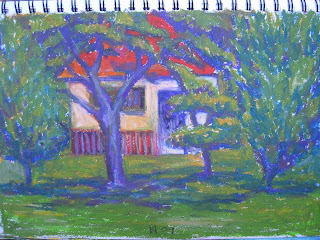LETTER TO A DESCENDENT 200 YEARS FROM NOW
Hello to my descendents.
By the time you read this the dust that was my body will be incorporated back into the universe. If you are reading this you may be curious to know what kind of person I was. That is difficult to describe. I have all the familiar human faults and frailties and no doubt others could describe my character better than I could myself.
However I can tell you some of my personal history. I was part of a family of five children and two parents ( I include two parents because 200 years from now this may not be a given-even now this is changing ). I was the second son of four boys and one girl. We all lived to adulthood and as I grew older I realised that in the lottery of life this in itself is lucky.
My childhood I can now look back on from a distance of 40 years and even though older memories perhaps take on a “golden hue” it was a relatively carefree time. We lived in a small village I wouldn’t describe as in the country but close to the sea and surrounded by nature reserves, golf courses, and to the west, farmland. What seemed at the time vast and empty areas to roam in. Add my parents hands-off parenting style, a group of children of the same or similar age and apart from a child’s normal anxieties you have a childhood more or less made in heaven.
I remember it now mainly in distinctive images and sounds that impressed themselves deeply on my particular sensibility. The honking “V” of geese flying south across a crisp cold sky turning to indigo. Walking through a copse of pine trees, dry brown pine needles crunching underfoot with the distinctive sough of wind in pine tree branches high up. Under a patch of gorse a Stone Chat’s nest, built into a hollow in the ground, with four tiny eggs inside. This was so rare a find that even though we collected birds eggs we left them in the nest.
My father and mother’s parenting style extended to a policy of no pocket money. At the time this seemed unfair and hard. Now I realise it fostered an ingenuity that became part of the warp and weft of childhood. My wife laughs at my memory of 3 or 4 kids swathed in duffle coats, scarves, hats and rubber boots on an icy wind blown winter day pushing an old unused pram along the beach collecting sea coal to sell for pocket money. The beach was known as treacherous and our ages ranged from 10 downwards. I remember this with some fondness. Collecting lost golf balls and selling them, returning drink bottles that then had a small refundable cash payment on them, if we needed money we found a way to get it.
All this may be strangely archaic to you, even the English I write may be like me reading the English of 200 years before my time.
The ancient Greeks visualized an individual’s life as a piece of woven cloth the Fates cut with shears at death. The analogy of warp and weft may hold good for a view larger than any individual life. We only seem able to visualize the more distant future as a golden age with all humanities social, economic and medical problems solved or shivering in a post-apocalyptic winter. Perhaps it may be interesting if I relate some of the strands I see currently developing in this time you may see resolved or still evolving. Currently stem cells are being grown in the hope of replacing diseased human organs. Another strand is the impetus to space travel out into the our Solar System. Another with perhaps unforeseen consequences is the apparent trend toward a rise in global temperature. Yet another the instability generated by underdeveloped nations in Africa and the East. What pressures each will exert on the other as they become part of the fabric of the future is hard for us to see. It also occurs to me that I am writing this for the internet, for us the most modern form of communication. For you perhaps a discarded form. Of interest only to historians, a gigantic frozen archive only accessible with outdated technology...........
To be continued
 "Poppy Fields near Argenteuil"
"Poppy Fields near Argenteuil"








































